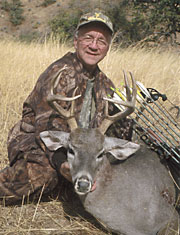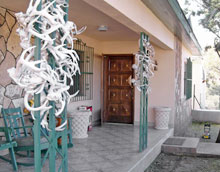May 05, 2011
By Dr. Dave Samuel
Coues whitetails may be small in stature, but they're huge in challenge and reward.
By Dr. Dave Samuel

Advertisement
Any typical 4x4 Coues buck will make the Pope and Young minimum score of 65. My Mexican buck netted 97 3/8. Note the typical Coues deer habitat of northern Mexico. |
Advertisement
To ward off the morning chill, I pulled my collar up tighter. Sure, this was Mexico and the temperature would warm up, but right now it was downright cold. I was trailing behind guide Brad Sanders, headed down into a steep canyon where I planned to spend the day in a treestand near a waterhole.
"Use your radio if you need me," Brad said. "Otherwise, I'll see you tonight after dark. And don't worry; it will warm up soon."
Brad quickly disappeared into the dark, and I settled into my stand. It was a beautiful, peaceful morning. With drought conditions, water was scarce and wildlife soon started coming in. Several rabbits visited the water, and many songbirds zipped in and out. A slight breeze came up the canyon, over the water to my stand, making me think, Perfect position. Mike and his guides have this stand in a great location. By 8 a.m. the temperatures started to rise, the wind died, and I knew that with the five-month drought and numerous tracks around the small pond, Coues deer would soon arrive.
Sure enough, 30 minutes later the parade started. First to show up were a doe and fawn. Talk about skittish! Those two deer took 30 minutes to make it to the water. Stop, start, stop, start. Eventually the fawn couldn't wait any longer and walked in to drink.
Over the next three hours, 31 does and fawns came to drink. Then, at 11:15, a decent 8-point came to water. My goal was to take a record-book Coues deer, and this one would qualify, but I decided to pass. With so many deer coming to water, a bigger buck likely would show up.
My hunch was confirmed when, 15 minutes later, antlers appeared in the thick vegetation to my left. Must be that buck that was here earlier, I thought. Then, as he moved through an opening, I did a double take. That's a different buck, a dandy buck! And he is headed for the water.
Whoops, not just yet. Rather than coming to water, the buck bedded 30 yards away. Coues deer have proportionally large ears, and they use them to great advantage -- a lesson I'd learned the hard way the previous morning. I was sitting at another waterhole when a smaller 8-point buck came down a steep slope 25 yards from my stand. As I slowly turned to get ready for a shot, my pants apparently brushed the seat of the stand. The buck never hesitated. He simply bolted down the canyon with his white tail swinging high. A minute later I spotted him a half-mile away, still running as he crossed a far ridge.
With that in mind, I now sat absolutely quiet. Even though the rut was in progress, this buck did not move as does came to drink. Numerous Encino oaks in the area were loaded with acorns, and occasionally the bedded buck would pick up an acorn and eat it.
Finally, 20 minutes later, the buck's hormones apparently kicked in and he rose and headed for the water -- and the doe that was already there. With sweat dripping off my brow, I realized I was as wired as this Coues buck.

Shed antlers displayed on the porch of the ranch house testify to the quality of bucks roaming the expansive Chairababi Ranch. |
The adventure started two years earlier when fellow Pope and Young member Dennis Dunn told me about the Chairababi Ranch in Mexico owned by Enrique Molina. Mike Whelan, from Sedona, Arizona, working with Enrique, guided hunters on this 12,000-acre, bow-only ranch. The success rate during dry years ran high, and after hearing Dennis's first-hand accounts of some great bowhunts, I accepted his invitation to hunt in the "Dennis & Friends 5th Annual Invitational Coues Deer Hunt."
Prior to the hunt I chatted with two friends with lots of Coues deer experience. Chuck Adams cautioned me not to take close shots, because Coues deer are notorious "string jumpers." Outdoor writing buddy Bob Robb told me to practice out to 50 yards, because getting close to these diminutive deer is tough. Both Adams and Robb hinted that Coues deer just might be the toughest of all the North American big game to take with a bow.
At the Tucson airport I met Dennis and a third bowhunter, Mark Colosi, from New York. Enrique Molina picked us up and we talked Coues deer during the 3 1/2-hour drive south into Mexico. I've always been puzzled about how to pronounce the name of this deer and asked Enrique about that. "A few folks call them 'cows' deer, but most say 'coos,'" Enrique said. He noted that Elliott Coues, the American military man after whom the deer are named, pronounced his name "cows."
"But cows are 'cows,'" Enrique concluded. "Deer are 'coos.'"
That's good enough for me. "Coos" deer it is.
Regardless of pronunciation, the Coues deer is a small version -- a really big buck will weigh 100 pounds -- of the whitetail. These deer live in the dry pine/oak hills and mesas of southern Arizona and New Mexico, and northern Mexico. While jaguars, coyotes, and bobcats prey on Coues deer, mountain lions are the major threat, and an abundant lion population keeps these deer wired. Combine that with the rather open habitat punctuated with lots of thorny, scrubby trees and brush, and stalking takes on a whole new meaning. It's tough.
However, when the weather is right -- meaning dry -- sitting at a waterhole can be a great way to get within range. Even then, however, getting a clean bow shot at a jumpy Coues deer can be a challenge. The latest edition of the Pope and Young record book lists about 275 Coues deer, a relatively low number. Limited geographic range partially explains that, but difficulty of hunting has a lot to do with it.
During our drive, Enrique said, "We've had only trace amounts of rain since August. Some waterholes are dry, but we've got treestands on others that are seeing lots of deer visits each day."
When we arrived at Chairababi, Mike Whelan greeted us and showed us around the lodge and bunkhouse. There were hot showers and lots of good food -- all the comforts of home.
With the land so dry, we obviously would be hunting over waterholes. Mike noted that Coues deer are like whitetails back home, in that they come to rattling and grunt ca
lls, but he advised us to spend the first couple of days just sitting quietly at water. "There is so much activity at these holes that if you stay perfectly still, eventually you will get a chance at a good buck."
On day one, Mike dropped me off at a waterhole tucked into a very steep canyon. The stand was located some 43 yards from the water, and the steep downhill angle would make any shots challenging. Eighteen deer came to water that day, including three bucks. About 3 p.m., I misjudged the distance on a great buck.
News back at camp that evening lifted my spirits -- Dennis and Mark both had taken record-book bucks. We were off to a great start.
As we left the ranch before daylight the next morning, I felt confident. Dennis had seen a number of deer from his stand, and I would be hunting that stand this day. And that's how I got into position to witness the parade of Coues deer starting shortly after daybreak and culminating about noon as the big 8-point rose from his bed and headed for the water.
The big guy never hesitated as he started to drink, giving me a quartering-away shot at 25 yards. I decided this shot was too good to pass up and ignored Chuck Adams' warning about Coues deer being prolific string-jumpers. As Chuck predicted, at the release, the buck jumped back. However, a bit of luck interceded, and the broadhead penetrated the neck vertebrae and put him down on the spot.
With a sigh of relief, I settled back into the treestand to let my heart rate slow down. Then I climbed a short way up the canyon to contact Brad on the radio. The hunt was over, but the memories were not. I'd killed a little deer. But he was a big one.

Hunting over water during a prolonged drought, our party went three for three as my companions, Mark Colosi (center) and Dennis Dunn (right) also took record-book bucks. |
Author's Notes:
Arizona and New Mexico have good populations of Coues deer, but the Sonora region of Old Mexico is growing in popularity, because the private ranches have lots of deer, controlled access, and big bucks.
When you hunt Coues deer, wear nothing but the quietest clothing, and silence your bow to the max.
You must have a passport to return to the United States from Mexico. No exceptions. Mike Miller offers custom guided Coues deer hunts in Mexico.
Northstar Productions out of Arizona has produced an interesting DVD on Coues deer hunting. For information, contact: Northstar Productions, www.northstarvideopro.com.

